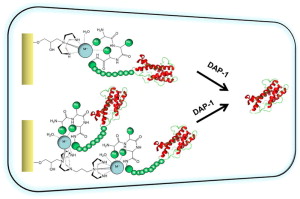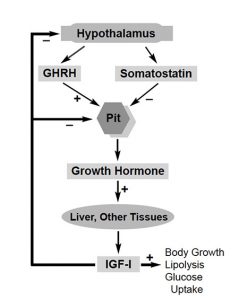Description
Recombinant human GHR is an active protein expressed from mammalian cells, with a C-terminal MFC-Avi tag. Its expression region is the DNA fragment encoding amino acid residues 27-264 of the human GHR protein. The purity of this GHR protein is greater than 95% as measured by SDS-PAGE. This recombinant Hormone GHR protein migrated to the band with a molecular weight of approximately 67 kDa on the gel. Its endotoxin level is less than 1.0 EU/ug determined by the LAL method. And its bioactivity has been validated in ELISA. In functional ELISA, this Biotinylated human GHR binds to human GH1, with a constant EC50 of 2067-3208 ng/ml. This biotinylated GHR protein could be used to isolate GHR antibodies from samples for further analysis with high sensitivity. It is in stock now.
GHR, a dimeric amino acid receptor, is widely expressed on GH target cells. The GH-GHR-IGF1 axis plays important roles in somatic growth, including cell proliferation, differentiation, division, cell cycle control, immunity, and survival. Aberrations in GHR signalling have been linked to various diseases and chronic conditions such as cancer, ageing, and inflammation.
Purity: greater than 95% as determined by SDS-PAGE.
Endotoxin: Less than 1.0 EU/ug as determined by the LAL method.
Activity
Measured by its binding capacity in a functional ELISA. Immobilized human GH1 (CSB-MP009407HU) at 2 µg/ml can bind to biotinylated human GHR, the EC50 is 2.067-3.208 ng/ml.

Destination Names: GHR
Uniprot No.: P10912
Alternative Names: (GH-binding protein)(GHBP)(serum-binding protein)
Species: Homo sapiens (Human)
Source: Mammalian cell
Expression region: 27-264aa
Mole Weight: 56.6
Protein length: Partial
Tag information: C-terminal MFC-Avi-tagged
Form: Lyophilized powder
Note: We will preferably ship the format we have in stock, however, if you have any special requirements for the format, please remark your requirement when placing the order, we will prepare according to your demand.
Buffer: Lyophilized from 0.2 μm filtered PBS, 6% trehalose, pH 7.4
Reconstitution
We recommend that this vial be briefly centrifuged before opening to bring the contents to the bottom. Reconstitute protein in sterile deionized water at a concentration of 0.1-1.0 mg/mL. We recommend adding 5-50% glycerol (final concentration) and an aliquot for long-term storage at -20°C/-80°C. Our final default glycerol concentration is 50%. Customers could use it for reference.
Storage Conditions
Store at -20°C/-80°C upon receipt, need to be aliquoted for multiple uses. Avoid repeated cycles of freezing and thawing.
Shelf life
Shelf life is related to many factors, storage condition, buffer ingredients, storage temperature and the stability of the protein itself. Generally, the shelf life of the liquid form is 6 months at -20°C/-80°C. The shelf life of the lyophilized form is 12 months at -20°C/-80°C.
Delivery time: 3-7 business days
Notes: Repeated freezing and thawing is not recommended. Store working aliquots at 4°C for up to one week.

Recombinant hormones
The hormone is a kind of biochemical substance produced by multicellular glands and then transported by the circulatory system to the target organ to coordinate its physiology and behaviour. Hormones function as a serious form of communication between different organs and tissues. Hormones regulate a variety of physiological and behavioural activities, as well as digestion, metabolism, respiration, tissue function, etc. Hormones deliberately affect the target tissue by binding to specific receptor proteins and causing a specific action on the target cell. When a hormone binds to the receptor protein, it results in the activation of a signal transduction mechanism.
Ultimately, this leads to cell-type-specific genomic responses that cause the hormone to activate genes that regulate protein synthesis. Hormones can be divided into two categories: water-soluble and fat-soluble. In the first category, like protein hormones and catecholamines, they are water-soluble and therefore easily transported through the circulatory system. The next category, like steroid and thyroid hormones, are fat-soluble. For their distribution, they must bind to carrier plasma glycoproteins to form ligand-protein complexes.
BiologicsCorp(BIC) mainly manufactures two types of hormones: parathyroid hormone (PTH) and exedin. Expedia is a hormone discovered from lizard venom, it plays a role in enhancing glucose-dependent insulin secretion, suppresses inappropriately elevated glucagon secretion, and slows gastric emptying in vivo, and this will be helpful in reducing the weight. PTH increases the concentration of calcium in the blood.
